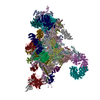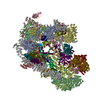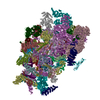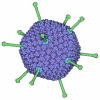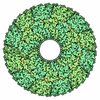[English] 日本語
 Yorodumi
Yorodumi- SASDB38: Inactivated complement factor 1 (C1) (Complement C1q subcomponent... -
+ Open data
Open data
- Basic information
Basic information
| Entry | Database: SASBDB / ID: SASDB38 |
|---|---|
 Sample Sample | Inactivated complement factor 1 (C1)
|
| Function / homology |  Function and homology information Function and homology informationcomplement subcomponent C_overbar_1r_ / complement subcomponent C_overbar_1s_ / complement component C1 complex / complement component C1q complex / extrinsic component of postsynaptic membrane / negative regulation of macrophage differentiation / synapse pruning / negative regulation of granulocyte differentiation / extrinsic component of presynaptic membrane / vertebrate eye-specific patterning ...complement subcomponent C_overbar_1r_ / complement subcomponent C_overbar_1s_ / complement component C1 complex / complement component C1q complex / extrinsic component of postsynaptic membrane / negative regulation of macrophage differentiation / synapse pruning / negative regulation of granulocyte differentiation / extrinsic component of presynaptic membrane / vertebrate eye-specific patterning / complement-mediated synapse pruning / collagen trimer / complement activation / zymogen activation / Classical antibody-mediated complement activation / Initial triggering of complement / neuron remodeling / molecular sequestering activity / complement activation, classical pathway / serine-type peptidase activity / astrocyte activation / Regulation of Complement cascade / microglial cell activation / synapse organization / cell-cell signaling / : / amyloid-beta binding / blood microparticle / postsynapse / immune response / innate immune response / serine-type endopeptidase activity / calcium ion binding / synapse / glutamatergic synapse / proteolysis / extracellular space / extracellular exosome / extracellular region / identical protein binding Similarity search - Function |
| Biological species | Homo sapiens (plasma purified) Homo sapiens (human) Homo sapiens (human) |
 Citation Citation |  Journal: Proc Natl Acad Sci U S A / Year: 2017 Journal: Proc Natl Acad Sci U S A / Year: 2017Title: Structure and activation of C1, the complex initiating the classical pathway of the complement cascade. Authors: Simon A Mortensen / Bjoern Sander / Rasmus K Jensen / Jan Skov Pedersen / Monika M Golas / Jens C Jensenius / Annette G Hansen / Steffen Thiel / Gregers R Andersen /  Abstract: The complement system is an important antimicrobial and inflammation-generating component of the innate immune system. The classical pathway of complement is activated upon binding of the 774-kDa C1 ...The complement system is an important antimicrobial and inflammation-generating component of the innate immune system. The classical pathway of complement is activated upon binding of the 774-kDa C1 complex, consisting of the recognition molecule C1q and the tetrameric protease complex C1rs, to a variety of activators presenting specific molecular patterns such as IgG- and IgM-containing immune complexes. A canonical model entails a C1rs with its serine protease domains tightly packed together in the center of C1 and an intricate intramolecular reaction mechanism for activation of C1r and C1s, induced upon C1 binding to the activator. Here, we show that the serine protease domains of C1r and C1s are located at the periphery of the C1rs tetramer both when alone or within the nonactivated C1 complex. Our structural studies indicate that the C1 complex adopts a conformation incompatible with intramolecular activation of C1, suggesting instead that intermolecular proteolytic activation between neighboring C1 complexes bound to a complement activating surface occurs. Our results rationalize how a multitude of structurally unrelated molecular patterns can activate C1 and suggests a conserved mechanism for complement activation through the classical and the related lectin pathway. |
 Contact author Contact author |
|
- Structure visualization
Structure visualization
| Structure viewer | Molecule:  Molmil Molmil Jmol/JSmol Jmol/JSmol |
|---|
- Downloads & links
Downloads & links
-Data source
| SASBDB page |  SASDB38 SASDB38 |
|---|
-Related structure data
| Similar structure data |
|---|
- External links
External links
| Related items in Molecule of the Month |
|---|
-Models
| Model #923 |  Type: atomic / Software: (CORALXL) / Radius of dummy atoms: 1.90 A / Symmetry: P2 / Chi-square value: 2.34  Search similar-shape structures of this assembly by Omokage search (details) Search similar-shape structures of this assembly by Omokage search (details) |
|---|---|
| Model #924 |  Type: atomic / Software: (CORALXL) / Radius of dummy atoms: 1.90 A / Symmetry: P2 / Chi-square value: 2.44  Search similar-shape structures of this assembly by Omokage search (details) Search similar-shape structures of this assembly by Omokage search (details) |
| Model #1959 |  Type: atomic / Software: (CORALXL) / Radius of dummy atoms: 1.90 A / Symmetry: P2 / Chi-square value: 2.30  Search similar-shape structures of this assembly by Omokage search (details) Search similar-shape structures of this assembly by Omokage search (details) |
- Sample
Sample
 Sample Sample | Name: Inactivated complement factor 1 (C1) / Entity id: 541 / 542 / 543 / 544 / 545 |
|---|---|
| Buffer | Name: 50 mM EPPS, 145 mM NaCl, 3 mM CaCl2 / pH: 8.5 |
| Entity #541 | Name: C1qc / Type: protein / Description: Complement C1q subcomponent subunit C / Formula weight: 23.687 / Num. of mol.: 6 / Source: Homo sapiens (plasma purified) / References: UniProt: P02747 Sequence: EDLCRAPDGK KGEAGRPGRR GRPGLKGEQG EPGAPGIRTG IQGLKGDQGE PGPSGNPGKV GYPGPSGPLG ARGIPGIKGT KGSPGNIKDQ PRPAFSAIRR NPPMGGNVVI FDTVITNQEE PYQNHSGRFV CTVPGYYYFT FQVLSQWEIC LSIVSSSRGQ VRRSLGFCDT ...Sequence: EDLCRAPDGK KGEAGRPGRR GRPGLKGEQG EPGAPGIRTG IQGLKGDQGE PGPSGNPGKV GYPGPSGPLG ARGIPGIKGT KGSPGNIKDQ PRPAFSAIRR NPPMGGNVVI FDTVITNQEE PYQNHSGRFV CTVPGYYYFT FQVLSQWEIC LSIVSSSRGQ VRRSLGFCDT TNKGLFQVVS GGMVLQLQQG DQVWVEKDPK KGHIYQGSEA DSVFSGFLIF PSA |
| Entity #542 | Name: C1qb / Type: protein / Description: Complement C1q subcomponent subunit B / Formula weight: 23.742 / Num. of mol.: 6 / Source: Homo sapiens (plasma purified) / References: UniProt: P02746 Sequence: QLSCTGPPAI PGIPGIPGTP GPDGQPGTPG IKGEKGLPGL AGDHGEFGEK GDPGIPGNPG KVGPKGPMGP KGGPGAPGAP GPKGESGDYK ATQKIAFSAT RTINVPLRRD QTIRFDHVIT NMNNNYEPRS GKFTCKVPGL YYFTYHASSR GNLCVNLMRG RERAQKVVTF ...Sequence: QLSCTGPPAI PGIPGIPGTP GPDGQPGTPG IKGEKGLPGL AGDHGEFGEK GDPGIPGNPG KVGPKGPMGP KGGPGAPGAP GPKGESGDYK ATQKIAFSAT RTINVPLRRD QTIRFDHVIT NMNNNYEPRS GKFTCKVPGL YYFTYHASSR GNLCVNLMRG RERAQKVVTF CDYAYNTFQV TTGGMVLKLE QGENVFLQAT DKNSLLGMEG ANSIFSGFLL FPDMEA |
| Entity #543 | Name: C1qa / Type: protein / Description: Complement C1q subcomponent subunit A / Formula weight: 23.687 / Num. of mol.: 6 / Source: Homo sapiens / References: UniProt: P02745 Sequence: EDLCRAPDGK KGEAGRPGRR GRPGLKGEQG EPGAPGIRTG IQGLKGDQGE PGPSGNPGKV GYPGPSGPLG ARGIPGIKGT KGSPGNIKDQ PRPAFSAIRR NPPMGGNVVI FDTVITNQEE PYQNHSGRFV CTVPGYYYFT FQVLSQWEIC LSIVSSSRGQ VRRSLGFCDT ...Sequence: EDLCRAPDGK KGEAGRPGRR GRPGLKGEQG EPGAPGIRTG IQGLKGDQGE PGPSGNPGKV GYPGPSGPLG ARGIPGIKGT KGSPGNIKDQ PRPAFSAIRR NPPMGGNVVI FDTVITNQEE PYQNHSGRFV CTVPGYYYFT FQVLSQWEIC LSIVSSSRGQ VRRSLGFCDT TNKGLFQVVS GGMVLQLQQG DQVWVEKDPK KGHIYQGSEA DSVFSGFLIF PSA |
| Entity #544 | Name: C1r / Type: protein / Description: Complement C1r subcomponent / Formula weight: 78.212 / Num. of mol.: 2 / Source: Homo sapiens / References: UniProt: P00736 Sequence: SIPIPQKLFG EVTSPLFPKP YPNNFETTTV ITVPTGYRVK LVFQQFDLEP SEGCFYDYVK ISADKKSLGR FCGQLGSPLG NPPGKKEFMS QGNKMLLTFH TDFSNEENGT IMFYKGFLAY YQAVDLDECA SRSKSGEEDP QPQCQHLCHN YVGGYFCSCR PGYELQEDTH ...Sequence: SIPIPQKLFG EVTSPLFPKP YPNNFETTTV ITVPTGYRVK LVFQQFDLEP SEGCFYDYVK ISADKKSLGR FCGQLGSPLG NPPGKKEFMS QGNKMLLTFH TDFSNEENGT IMFYKGFLAY YQAVDLDECA SRSKSGEEDP QPQCQHLCHN YVGGYFCSCR PGYELQEDTH SCQAECSSEL YTEASGYISS LEYPRSYPPD LRCNYSIRVE RGLTLHLKFL EPFDIDDHQQ VHCPYDQLQI YANGKNIGEF CGKQRPPDLD TSSNAVDLLF FTDESGDSRG WKLRYTTEII KCPQPKTLDE FTIIQNLQPQ YQFRDYFIAT CKQGYQLIEG NQVLHSFTAV CQDDGTWHRA MPRCKIKDCG QPRNLPNGDF RYTTTMGVNT YKARIQYYCH EPYYKMQTRA GSRESEQGVY TCTAQGIWKN EQKGEKIPRC LPVCGKPVNP VEQRQRIIGG QKAKMGNFPW QVFTNIHGRG GGALLGDRWI LTAAHTLYPK EHEAQSNASL DVFLGHTNVE ELMKLGNHPI RRVSVHPDYR QDESYNFEGD IALLELENSV TLGPNLLPIC LPDNDTFYDL GLMGYVSGFG VMEEKIAHDL RFVRLPVANP QACENWLRGK NRMDVFSQNM FCAGHPSLKQ DACQGDSGGV FAVRDPNTDR WVATGIVSWG IGCSRGYGFY TKVLNYVDWI KKEMEEED |
| Entity #545 | Name: C1s / Type: protein / Description: Complement C1s subcomponent / Formula weight: 74.886 / Num. of mol.: 2 / Source: Homo sapiens / References: UniProt: P09871 Sequence: EPTMYGEILS PNYPQAYPSE VEKSWDIEVP EGYGIHLYFT HLDIELSENC AYDSVQIISG DTEEGRLCGQ RSSNNPHSPI VEEFQVPYNK LQVIFKSDFS NEERFTGFAA YYVATDINEC TDFVDVPCSH FCNNFIGGYF CSCPPEYFLH DDMKNCGVNC SGDVFTALIG ...Sequence: EPTMYGEILS PNYPQAYPSE VEKSWDIEVP EGYGIHLYFT HLDIELSENC AYDSVQIISG DTEEGRLCGQ RSSNNPHSPI VEEFQVPYNK LQVIFKSDFS NEERFTGFAA YYVATDINEC TDFVDVPCSH FCNNFIGGYF CSCPPEYFLH DDMKNCGVNC SGDVFTALIG EIASPNYPKP YPENSRCEYQ IRLEKGFQVV VTLRREDFDV EAADSAGNCL DSLVFVAGDR QFGPYCGHGF PGPLNIETKS NALDIIFQTD LTGQKKGWKL RYHGDPMPCP KEDTPNSVWE PAKAKYVFRD VVQITCLDGF EVVEGRVGAT SFYSTCQSNG KWSNSKLKCQ PVDCGIPESI ENGKVEDPES TLFGSVIRYT CEEPYYYMEN GGGGEYHCAG NGSWVNEVLG PELPKCVPVC GVPREPFEEK QRIIGGSDAD IKNFPWQVFF DNPWAGGALI NEYWVLTAAH VVEGNREPTM YVGSTSVQTS RLAKSKMLTP EHVFIHPGWK LLEVPEGRTN FDNDIALVRL KDPVKMGPTV SPICLPGTSS DYNLMDGDLG LISGWGRTEK RDRAVRLKAA RLPVAPLRKC KEVKVEKPTA DAEAYVFTPN MICAGGEKGM DSCKGDSGGA FAVQDPNDKT KFYAAGLVSW GPQCGTYGLY TRVKNYVDWI MKTMQENSTP RED |
-Experimental information
| Beam | Instrument name: PETRA III EMBL P12 / City: Hamburg / 国: Germany  / Type of source: X-ray synchrotron / Wavelength: 0.124 Å / Type of source: X-ray synchrotron / Wavelength: 0.124 Å | ||||||||||||||||||||||||
|---|---|---|---|---|---|---|---|---|---|---|---|---|---|---|---|---|---|---|---|---|---|---|---|---|---|
| Detector | Name: Pilatus 2M | ||||||||||||||||||||||||
| Scan |
| ||||||||||||||||||||||||
| Distance distribution function P(R) |
| ||||||||||||||||||||||||
| Result | Comments: The expected MW quoted above (733 kDa) is calculated from the amino acid sequence of the oligomeric complex. The experimental MW of 790 kDa takes into account additional post-translational ...Comments: The expected MW quoted above (733 kDa) is calculated from the amino acid sequence of the oligomeric complex. The experimental MW of 790 kDa takes into account additional post-translational modifications of the protein. The models displayed in this entry - sequentially from top to bottom - represent those presented in Figure 4c of the main text and Supplementary Figures 2e and 4b, respectively, of Mortensen et al., 2017 Proc Natl Acad Sci U S A 114(5):986-991 .
|
 Movie
Movie Controller
Controller

